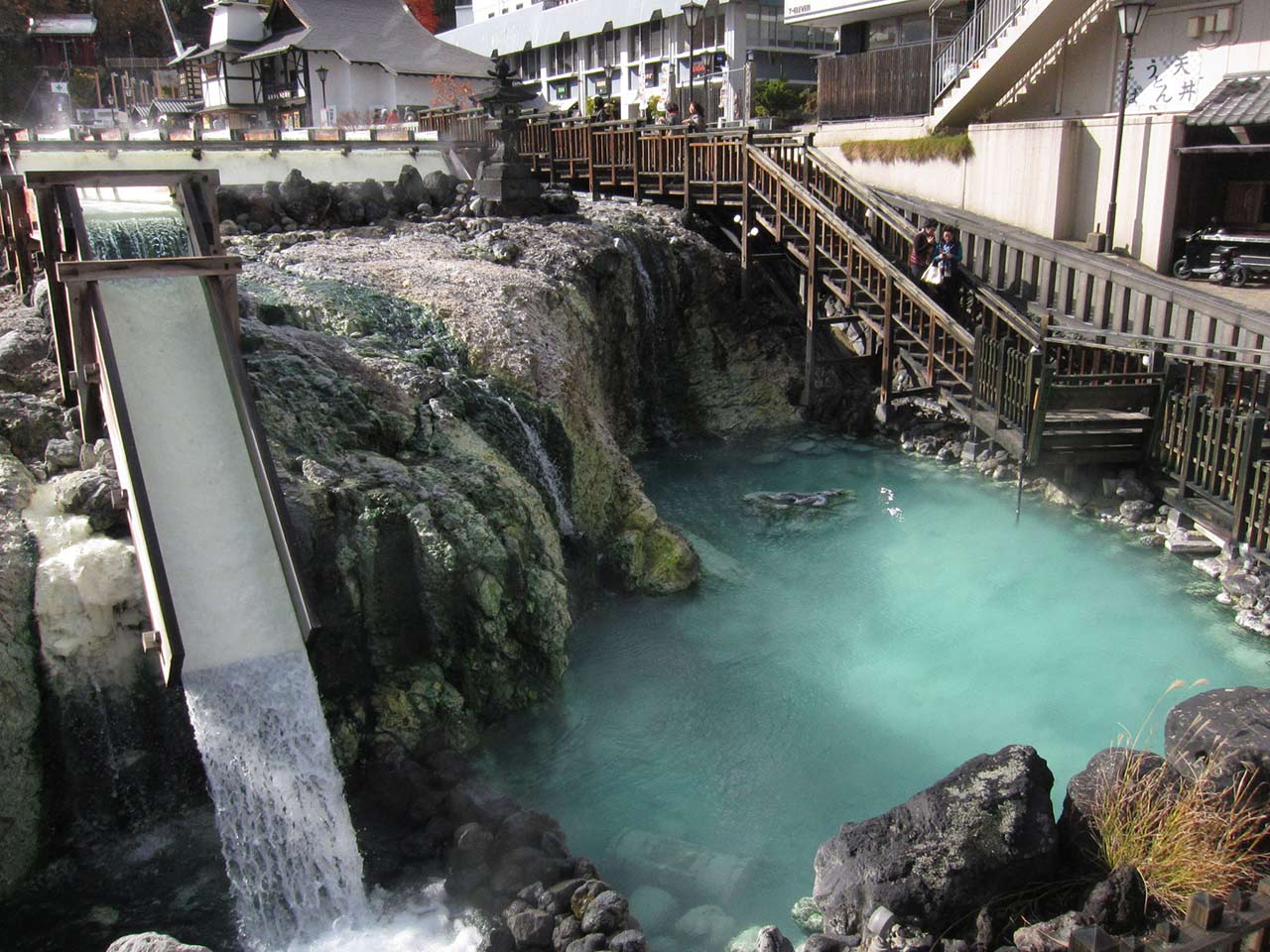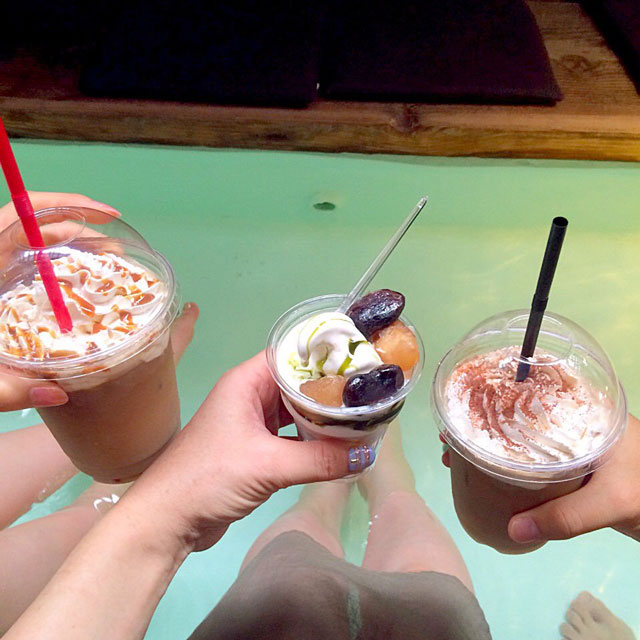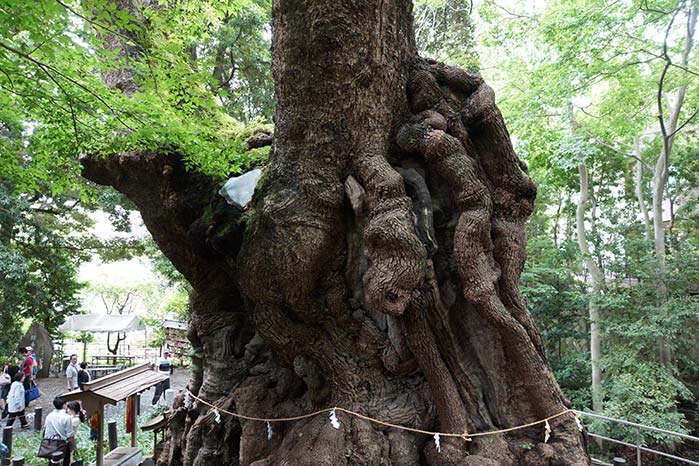One of the best things you can do during your vacation in Japan is visit an onsen. Sinking into the super hot water and soaking up those natural minerals surrounded by picturesque vistas – there's nothing better. Well, there's one thing better: 温泉街, onsen resort towns.
Take the superbly relaxing experience of onsen and multiply it by an entire town. Tons of hot springs, plus fun things to do, plus a comfy place to stay. It's the ultimate onsen experience by far.
But choosing an onsen resort town to stay at can be difficult because there are over 223 in Japan1. You'll probably have a fine time at any of them, but we narrowed it down to the top 10, so you can plan the best onsen getaway with complete confidence.
- About Onsen and This List
- 1. Beppu Onsen (Oita Prefecture)
- 2. Kusatsu Onsen (Gunma Prefecture)
- 3. Atami Onsen (Shizuoka Prefecture)
- 4. Yufuin Onsen (Oita Prefecture)
- 5. Hakone Onsen (Kanagawa Prefecture)
- 6. Dogo Onsen (Ehime Prefecture)
- 7. Gero Onsen (Gifu Prefecture)
- 8. Kinugawa Onsen (Tochigi Prefecture)
- 9. Arima Onsen (Hyogo Prefecture)
- 10. Noboritetsu Onsen (Hokkaido Prefecture)
- Choosing the Best Onsen Experience For You
About Onsen and This List
10% of the world's active volcanoes are in Japan. That means there are thousands of volcanoes, and thanks to them, we end up with thousands of natural hot springs or onsen 温泉. The main reason people visit onsen is to take a dip and relax in the hot water that naturally springs out of the earth. But there's more to it than just hot water. Many people in Japan believe hot springs can help you recover from physical exhaustion as well as other health issues such as anxiety, skin problems, and even diabetes.
- 温泉(おんせん)
- hot spring
In Japan, people have been soaking in baths and onsen since the Nara period, and the tradition is still going strong. Many Japanese people soak in a hot bath at the end of each day to unwind. But when they're looking for a deeper level of relaxation, they visit an onsen resort town for a weekend getaway. Usually, an onsen is a public bath that people share, though sometimes hotels have rooms with private onsen. Most onsen are separated by gender, but some are konyoku 混浴 (mixed baths), where men and women can bathe together. Getting naked with your friends, neighbors, or the locals might feel weird at first, but it's a great experience both physically and mentally.
Going to an onsen resort town takes the onsen experience and magnifies it. Rather than a few hours soaking, you have days on end to soak in several onsen, do activities, eat amazing food, and experience the town. That's because the town is filled with accomodations, especially traditional Japanese style inns called ryokan.
This list is in no particular order, so we're not "ranking" these towns per se. However, these are the very best onsen out of the 223 resort towns in Japan, which all together have 3,000+ resorts. So no matter which of these ten towns you choose visit, you'll be soaking in the cream of the crop.
1. Beppu Onsen (Oita Prefecture)

- 地獄めぐり(じごくめぐり)
- "hell hopping," visiting one high steam onsen after another
Beppu 別府, on the island of Kyushu, is a mecca for onsen lovers because of its sheer hot spring volume; it has the largest volume of hot spring flows in Japan, and the second largest in the world (after Yellowstone National Park).
There are hundreds of luxurious onsen in Beppu, but the city is really known for its geothermal hot springs that kick up a lot of steam. These steamy onsen are known as jigoku, or hells. They're so special that tourists make it a point to "hell hop," or visit many steamy onsen as they can in a row. This practice is called jigokumeguri 地獄めぐり in Japanese. Unfortunately, you can't bathe in the jigoku (they're too hot to bathe in, you'll cook like a human potato), but you can enjoy dipping in your feet in some of them.
If hundreds of hot springs and the hellish motif isn't enough for you, Beppu will be adding an onsen amusement park in the near future. There will be splashy rides and even hot tubs right in the roller coaster cars. Check the video above to get an idea of what the onsen amusement park will be like.
Another reason we love Beppu is their mascot Beppyon. We reached out to this onsen bunny rabbit and received the Yuru Kyara's special message for Tofugu readers:

「別府市には、 別府八湯っていう8ヶ所の温泉地があって、これらをまとめて 別府温泉郷 って呼んでいるんだぴょん。別府八湯っていうのは、別府・浜脇・観海寺・堀田・明礬・鉄輪・柴石・亀川の各温泉地のことで、それぞれが、それぞれの特徴を持っているんだ。別府市には10種類ある掲示用泉質のうち、7種類の泉質が確認されていて、2,292の 源泉があるんだよ、毎分の湧出量は87,326L。これは、人間が入れる温泉としては世界一の源泉数・湧出量を誇るんだぴょん。」
"Beppu city has eight onsen areas called Beppu Hachi Yu and we call the whole area Beppu Onsenkyo PYON. It includes Beppu, Hamawaki, Kankaiji, Hotta, Myouban, Kannawa, Shibaseki and Kamegarwa, each of which has its own feature. Beppu has 7 types of spring quality out of 10 and 2,292 gensen, sources of hot spring. The amount of discharge is 87,346L per a minute, it's world No.1 for onsen that people can bathe in PYON."
- Beppyon, Beppu City Official Yuru Kyara ゆるキャラ
ADDITIONAL INFORMATION
Website:
Address:
Highlights:
- Japan's largest volume of hot springs
- Fun "Hell Hopping" activity
- If you're an onsen lover, you can't miss this place
Access:
- By Train to Beppu
- From Tokyo, JR Sanyo Shinkansen and JR Nippo Main Line (5h 40min)
- From Shin Osaka, JR Sanyo Shinkansen and JR Nippo Main Line (3h 10min)
- From Hakata, JR Nippo Main Line (1h 55min)
- By Air to Oita Airport
- From Haneda (Tokyo) Big Bird, ANA, JAL or SNJ (1h 40min)
- From Itami (Osaka) Osaka International, ANA or JEX (1hr)
- From Oita Airport to Beppu, Oita Kotsu Bus (50min)
- By Ferry to Beppu Kokusai (International) Tourist Port
- From Osaka Nanko (Osaka), Ferry-Sunflower Co., Ltd. (11h 40min)
- By Car to Beppu
- From Fukuoka, Oita Expressway (143km, 1h 50min)
- From Kumamoto, Yamanami Highway (147km, 3hrs)
- From Oita Airport, Route 10 & Oita Airport Expressway (40.5km, 40min)
2. Kusatsu Onsen (Gunma Prefecture)

Kusatsu 草津 is an onsen resort town frequently ranked number one by a lot of travel agencies and other Japanese media outlets. One of the things that makes it so special is an area in the center of town called the yubatake 湯畑 (hot spring field), where approximately 8,533 gallons of spring water gushes out and forms a waterfall. Thanks to the perfect combination of sun and air hitting the water, its mineral deposits crystalize, turning the yubatake into a natural salt water bath, or yunohana 湯の花 (hot spring flower).
But what makes this onsen spectacular is yumomi 湯もみ, Kusatsu's traditional method of hand-stirring the water with long planks and synchronized moves while singing. At 149ºF, this onsen would normally be too hot to soak in, but because of the yumomi stirring, the yubatake's water cools down to the perfect bathing temperature. You can even join in and participate in this lively yumomi activity at Netsunoyu.
And if you're a snowboarder or skier, they have the Kusatsu Kokusai Ski Resort, where visitors can enjoy a soak in a hot onsen after a long day of chilling winter sports.
If you're still not convinced Kusatsu is an awesome onsen resort town, check out the beautiful video the Kusatsu Onsen Tourist Association released.
Of course, you'll need something sweet to help you enjoy your onsen soak. You can get sweets, drinks, and ashiyu 足湯 (foot bathing) at a café inside the Yubatake Souan hotel, right in front of yubatake.
ADDITIONAL INFORMATION

Website:
Address:
Highlights:
- Yubatake (Hot spring field) in the center of town
- Fun activity "Yumomi"
- Great access to ski area
Access:
- By Train to Kusatsu
- From Tokyo, JR Hokuriku Shinkansen and Kusakaru Bus or Seibu Kougen Bus (2h 30min to 3hrs)
- By Bus to Kusatsu
- From Tokyo, JR Joshu Yumeguri Expressway bus (4hrs)
- By Car to Kusatsu
- From Tokyo, Kan-etsu Expressway (175km, 3h 15min)
3. Atami Onsen (Shizuoka Prefecture)

Atami 熱海 is both an onsen resort town and a beach town. It's located by the Pacific Ocean and is famous for the dynamic fireworks shows they hold throughout the year (you can check the schedule here). Its easy access from Tokyo (about one hour by shinkansen) is another reason for its popularity. They also have unique places for tourists, such as Atami Trick Art Museum, Atami Sex Museum, and Fūun Bunko, a museum that for some reason has Hitler mementos.
Another spot to visit in the Atami area is an ancient, spiritual tree called 大楠 Great Camphor in Kinomiya Shrine. The gnarled tree is 2,000 years old and is the second biggest camphor tree in Japan. They say walking around it makes your dreams come true, and each pass will add a year to your life.
ADDITIONAL INFORMATION

Website:
Address:
Highlights:
- Beach resort
- Easy access from Tokyo
- Fireworks on the ocean
Access:
- By Train to Atami
- From Tokyo, JR Tokaido Shinkansen (50min)
- From Shin-Osaka, JR Tokaido Shinkansen (2h 30min)
- By Car to Atami Kusatsu
- From Tokyo, Tomei Expressway and Odawara-Atsugi Road (100km, 1h 50min)
4. Yufuin Onsen (Oita Prefecture)

- 豊後富士(ぶんごふじ)
- The Mt. Fuji of Bungo
Yufuin 由布院 is another of Japan's best onsen towns, nestled away in Oita prefecture. It's in Yufu, a city west of Beppu and at the foot of the beautiful mountain called Bungofuji 豊後富士 (the Mt. Fuji of Bungo). Unlike other ancient onsen towns, this one has modern comforts. You can find trendy restaurants, unique shops of accessories, antiques or craft goods, and galleries of up-and-coming artists in a traditional townscape. The foggy scenery between fall and winter is majestic and tends to attract many visitors. Another main attraction of Yufuin is Kinrin Lake Kirinko 金鱗湖, which is both a hot spring and regular (not hot) spring that gushes up from the bottom of the lake.
If you're still not convinced, check out this promo video by the Youth League of Yufuin branch of Yufushi Societies of Commerce and Industry. It really highlights the hip, fashionable spirit of this onsen resort town.
ADDITIONAL INFORMATION
Website:
Address:
Highlights:
- Bungo Fuji and Kirin Lake
- Modern comforts (Restaurants/Art galleries/Shops)
- Majestic foggy scenery
Access:
- By Air to Oita Airport
- From Haneda (Tokyo) Big Bird, ANA, JAL or SNJ (1h 40min)
- From Itami (Osaka) Osaka International, ANA or JEX (1hr)
- From Oita Airport to Yufuin, Kamenoi Bus (55min)
- By Train
- From Fukuoka, JR Kyushu Yufuin-no-mori-go Express (2h 10min)
- By Bus
- From Fukuoka, Nishitetsu Yufuin-go Expressway Bus (2hrs)
5. Hakone Onsen (Kanagawa Prefecture)

Autumn in Hakone is especially stunning when fiery red leaves blanket the mountains. It's nothing short of breathtaking.
Hakone 箱根 is another onsen resort town that is easily accessible from Tokyo. It sits at a 2,297 feet above sea level with beautiful mountains, volcanoes, art museums, not to mention Lake Ashi. It's only little over an hour from Shinjuku, which lets people in Tokyo enjoy an onsen day trip. If you like scenic rides, you can travel to the top of a mountain via the Hakone Ropeway and see steam from its volcanic activity on the way up.
If you're an onsen beginner and not ready to get naked with strangers, Hakone Kowakien Yunessun has you covered (literally). It's an onsen amusement park where you can enjoy soaking in the onsen in your swimsuit (at least until you graduate to the real thing). They even have themed baths like a sake bath, green tea bath, and hot water slide. They're all co-ed too, so you can enjoy them with all of of your friends, family, and loved ones.
When you go to Owakudani, a valley created by the eruption of Mount Hakone 3,000 years ago, you'll want to get some black eggs as omiyage. These almost-chicken babies are boiled in an onsen, which turn the shells black from the iron in the water. The egg store Owakudani Kurotamagokan says it's proven that the black eggs contain 20% more umami than regular boiled eggs. It's also said this egg makes you live seven years longer.
One of Hakone's most memorable features is its beautiful views for every season. The fall is especially stunning when fiery red leaves blanket the mountains. It's nothing short of breathtaking.
ADDITIONAL INFORMATION

Website:
Address:
Highlights:
- Great access from Tokyo
- Volcano and ropeway
- Tasty black eggs that make you live longer
Access:
- By Train
- From Shinjuku, Odakyu Limited Express Romancecar (1h 25min)
- From Shin Osaka, JR Tokaido Shinkansen and Hakone Tozan Railway Hakone Tozan line (3h 15min)
- By Bus
- From Haneda Airport, Odakyu Hakone Expressway Bus (2h 30min)
- By Car
- From Tokyo, Tomei Expressway and Odawara-Atsugi Road (90km, 1h 25min)
6. Dogo Onsen (Ehime Prefecture)

Dogo 道後 is known for being an onsen resort town with 3,000 years of history. It's even recorded in the oldest history book in Japan, the Nihon Shoki 日本書紀. Dogo also appears in famous Japanese literature like Murasaki Shikibu's Genji Monogatari and Natsume Soseki's Botchan.
Dogo's most popular landmark is the retro public bathhouse, Dogo Onsen Main Building, which was built in 1894 and served as a model for the bathhouse in Hayao Miyazaki's Spirited Away. It has also been designated 重要文化財, Important Cultural Property.
Dogo started an annual art festival, Dogo Art, in 2014, celebrating the Dogo Onsen Main Building's 200-year anniversary. Every year, the town collaborates with artists such as world-famous designer Yayoi Kusama, photographer Mika Ninagawa, and modern ukiyo-e painter Akira Yamaguchi.
Dogo also has a 250-meter long shopping arcade where you can enjoy local foods and tons of shops that stay open into the night. Since Ehime prefecture is known for oranges (satsuma mandarins, to be exact), mikan onigiri みかんおにぎり (orange rice balls) cooked with 100% orange juice are a popular omiyage in the shopping arcade.
ADDITIONAL INFORMATION

Website:
Address:
Highlights
- Bathhouse landmark, the model of "Spirited Away"
- Historical significance for you nerds
- The Onsen Art Project
Access:
- By Train to Matsuyama Station
- From Tokyo, JR Tokaido Shinkansen and JR Seto-Ōhashi Line Express Train Shiokaze (6hrs)
- From Shin Osaka, JR Tokaido Shinkansen and JR Seto-Ōhashi Line Express Train Shiokaze (3h 30min)
- From Matsuyama to Dōgo, cab (30min) or Iyotetsu Shuttle Bus (40min)
- By Ferry to Matsuyama Tourist Port
- From Hiroshima, Setonaikaikisen Matsuyama Super Jet (1h 20min)
- From Matsuyama Tourist Port to Dōgo, cab (20min) or Iyotetsu Shuttle Bus (40min)
- By Air to Matsuyama Airport
- From Haneda (Tokyo), ANA or JAL (1h 20min)
- From Itami (Osaka) Osaka International, ANA or JAL (50min)
- From Matsuyama Airport to Dōgo, cab (30min) or Iyotetsu Shuttle Bus (40min)
7. Gero Onsen (Gifu Prefecture)

Gero 下呂 is recorded as one of the three greatest onsen in Japan in a document from the Muromachi period (the other two recorded great onsen are Kusatsu and Arima). It's 1.5 hours away from Nagoya by train or car. Gero is home to Onsen Gassho Mura, a village of traditional Japanese gassho-style houses for tourists to explore. You can also enjoy Gero's delicious wagyu beef, Hida-gyu. If all that's not enough, there's even fireworks during the summer and winter.
You're probably used to seeing a YouTube video for each resort town by now. Check out the one above if you need proof beyond words that Gero is worthy of your naked body soakage. Kids today and their "moving pictures."
ADDITIONAL INFORMATION
Website:
Address:
Highlights:
- Popular onsen town in Tokai region
- Fireworks on the river
- Hida-gyu beef
Access:
- By Train
- From Tokyo, JR Tokaido Shinkansen and JR Limited Express Wide View Hida (3h 30min)
- From Shin Osaka, JR Tokaido Shinkansen and JR Limited Express Wide View Hida (2h 50min)
- From Nagoya, JR Limited Express Wide View Hida (1h 30min)
- By Car
- From Tokyo, Chuo Jidosha-do (350km, 4h 40min)
- From Nagoya, Tōkai Hokuriku Jidosha-do (120km, 2hrs)
8. Kinugawa Onsen (Tochigi Prefecture)

Kinugawa Onsen is in Nikko, one of the best places to visit in Japan, period.
Kinugawa 鬼怒川 is located in Kinugawa valley. There are a lot of hotels perched along the river, offering a fantastic view of the valley below. It's also in Nikko, one of the best places to visit in Japan, period, because of the Nikko Tosho-gu Shrine and the cultural Nikko Edo Wonderland theme park. This makes it the perfect place to stay for sightseeing. You can go rafting through the valley and become one with nature, all without straying more than two hours from Shinjuku.
If you're tired of soaking in amazing baths and seeing World Heritage sites, you can go see 102 of the world's most famous landmarks at Tobu World Square. Well, the landmarks are 1/25 scale miniatures on the grounds surrounding the "architectural museum," but they're pretty impressive miniatures! And the park is a fun place to walk around and explore.
If you are planning to go to Kinugawa by Tobu Line Special Express Spacia, you might be able to meet the cute conductor Miyabi Kinugawa. She is the Spacia train's mascot character, made for otaku.
ADDITIONAL INFORMATION

Websites:
- Yado Good! By Kinugawa Onsen Ryokan Association
- Nikko Kinugawa Travel Guide by Nikko City Tourism Association
Address:
Highlights:
- Valleys and rivers
- Outdoor activities
- Tons of tourist spots
Access:
- By Train to Kinugawa Onsen Station
- From Shinjuku, JR Limited Express (2hrs)
- From Asakusa, Tobu Limited Express (2hrs)
- By Car
- From Tokyo, Tōhoku Jidosha-do (160km, 2h 30min)
9. Arima Onsen (Hyogo Prefecture)

Arima 有馬 is one of the three greatest hot springs in Japan, along with Kusatsu and Gero, as recorded in a famous poem from the Muromachi period. It's also one of the "three ancient springs" in Japan, according to old history books like the Nihon Shoki and Fudoki.
Arima is a popular destination for people living in the Kansai region because of its accessibility from Osaka, Kyoto, and Kobe. In Arima, you can enjoy unique hot springs, such as kinsen 金泉 (gold spring), also known as akayu 赤湯 (red bath). Kinsen has an intense red-brown colored and contains iron. There's also ginsen 銀泉 (silver spring), which is colorless and carbonated.
You can buy Arima Cider – the first soda water ever made in Japan – along with a bunch of other onsen-related omiyage at Yoshitakaya. The Arima Cider label explains a bit of history about the product: the carbonated onsen water was originally thought to be poisonous because of its bubbles and foam. People were actually afraid to drink it. It wasn't until the Meiji period that scientists discovered it was, in fact, quite healthy to drink.
The most distinct feature of Arima is that it's one of the best onsen towns in Japan, but has no nearby volcanoes – a rare phenomenon hardly seen anywhere in the world. The spring water of Arima can be traced back to hot water generated by the dehydrating action of rocks from the Philippine Sea plate. This heated water then rises up through the cracks in underground bedrock, creating an onsen for all to enjoy.
Here a promotional video for Arima made by an exchange student from Poland that introduces us to the beauty benefits of Japanese hot springs. Later in this video (from 5:04 on) she also describes the features of the Arima Onsen.
There's also Arimagawa Shinsui Hiroba 有馬川親水広場, which is a park on the river running through the onsen town. It's a popular place for taking pictures and short walks.
ADDITIONAL INFORMATION

Website:
Address:
Highlights:
- Hot springs with no volcanic source
- Various kinds of hot spring
- The origin of Japanese cider
- Neato park
Access:
- By Train
- From Kyoto, JR Tokaido Shinkansen, Hokushin Express and Kobe Electric Railway (1hr)
- By Bus
- From Kansai International Airport, Osaka Airport Transport Airport Limousine and JR Bus or Hankyu Bus (1h 30min)
- From Umeda (Osaka), JR Bus or Hankyu Bus (1h 30min)
- By Car
- From Osaka, Hankyu and Route 11 Ikeda Line and Chugoku Jidoshado (40km, 40min)
10. Noboritetsu Onsen (Hokkaido Prefecture)

- 地獄祭り(じごくまつり)
- Hell Festival
Noboribetsu 登別 is an onsen resort town in Hokkaido, the northernmost island of Japan. Even though access from the main island is not "convenient" compared to other onsen resort towns on this list, it's still one of the most popular onsen destinations in Japan. They have multiple types of hot springs such as sulfur and sulfurated hydrogen baths, which soften and whiten your skin. And there are also iron springs, which help you recover from physical exhaustion. It's the ideal onsen resort for skiers and snowboarders, thanks to the majestic scenery you just can't get on the main island.
Jigokudani 地獄谷, or Hell Valley, is must-visit. The dramatic image of this smoking valley is stunning, and its appearance changes with each season. At the end of August, Noboribetsu hosts the Jigoku Matsuri 地獄祭り, or Hell Festival. Enma 閻魔, the big bad boss of hell is followed by akaoni 赤鬼 (red demons) and aooni 青鬼 (blue demons). You'll get to see huge demon-shaped cars and Omikoshi. At night, you can take part in bon odori and watch fireworks. Check out this site to plan your visit for the event.
Enma Yakisoba, a spicy yakisoba named after the boss demon, is a popular local food in Noboribetsu. It goes great with all the hellish festivities you'll be enjoying during your stay.
To add some drunken mirth to your underworld activities, order a popular local beer called Kin-oni Pale Ale 金鬼ペールエール, named after a golden demon.
ADDITIONAL INFORMATION

Website:
Address:
Highlights:
- Great access to skiing and snowboarding areas
- Jigokudani (Hell Valley)
- Demon-related foods and drinks
Access:
- By Train
- From Sapporo, JR Express Super Hokuto, JR Express Hokuto, Ltd. or JR Express Suzuran (1h 10min)
- By Bus
- From New Chitose Airport, Donan Bus Kosoku Onsen Go (1hr)
- By Car
- From Hakodate, Douo Jidoshado (210 km, 2h 50 min)
Choosing the Best Onsen Experience For You
Congratulations! You now know the 10 best onsen resort towns in Japan. As you plan your trip, make sure you take everything into account:
- How far away is it?
- What activities do you like best?
- What kind of food do you want to eat?
- Do you want to stare into the pits of hell?
- How many days can you stay in a sulfur bath before you shrivel away into nothing?
Each town is going to offer superb soaking experiences, so make your choices based on the extracurriculars (you'll want something fun for the 10% of the time you're not bathing).
Whatever you pick, every town on this list is a winner. Remember, there are 223 resort towns in Japan, so these are in the top 4.4%. You can't get much better than that. So what are you waiting for? Go book your trip and start dreaming of the relaxing vacation you've always wanted!
